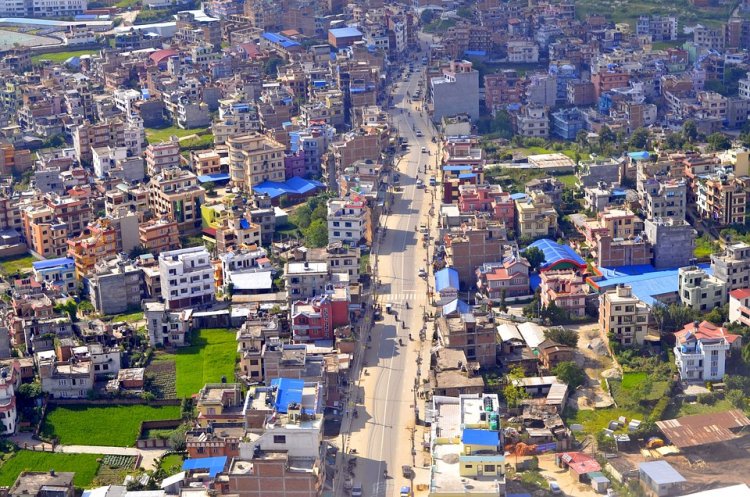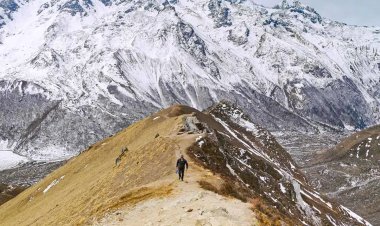Everything That You Need To About about Kathmandu The History, Culture, and Tourism
Learn about the fascinating city of Kathmandu, nestled in the heart of the Himalayas. Explore its rich history, vibrant culture, and top tourist attractions in this comprehensive guide.

Introduction:
Nestled in the embrace of the Kathmandu Valley, Kathmandu, the capital city of Nepal, unfolds as a captivating destination enriched with a tapestry of history, culture, and natural beauty. As we embark on this journey to learn more "About Kathmandu", we will delve into its geography, climate, rich history, cultural gems, and renowned places that make it a must-visit destination for travelers seeking a truly immersive experience. From its ancient roots to the vibrant pulse of its present-day, Kathmandu beckons with a charm that resonates through its landscapes, landmarks, and the warmth of its people. Let's unravel the essence of this enchanting city and discover what sets it apart as a unique and compelling destination.
Geography and Climate:
Nestled in the embrace of the Kathmandu Valley, the geographical wonders of Kathmandu create an enchanting backdrop, inviting travelers to a city where nature and culture intertwine seamlessly.
Picture-perfect hills like Shivapuri, Phulchoki, Nagarjun, and Chandragiri cradle Kathmandu, providing not only breathtaking views but also shaping the city's cultural and spiritual identity. These hills, more than just scenic delights, play a role akin to guardians, influencing the city's weather and creating unique pockets of climate diversity.
Adding to the allure is the sacred Bagmati River, flowing through the heart of the city. Beyond being a mere geographical feature, this river is a lifeline of spirituality, woven into the cultural fabric of Kathmandu. Its holy waters and the rituals along its banks offer a captivating glimpse into the spiritual heartbeat of the city.
As the seasons change, so does the city's character. Kathmandu experiences a warm subtropical climate, where summers bring a touch of warmth and winters introduce a refreshing coolness. The magic happens between September and November when the weather is at its finest - dry, crisp, and inviting, creating the perfect canvas for exploration.
The hills surrounding Kathmandu not only frame the city but also serve as natural viewpoints. Imagine standing atop these vantage points, soaking in panoramic views of the Kathmandu Valley and the majestic Himalayan range – a visual treat that adds an extra layer of awe to the city's natural beauty.
In essence, Kathmandu's geography and climate are not just facets of the city; they are characters in a captivating story. The hills, the river, the changing seasons – each element engages visitors in a narrative that unfolds with every step, making Kathmandu not just a destination but an immersive experience waiting to be discovered.
History:
Kathmandu, with a history spanning over 2,000 years, stands as the vibrant capital of Nepal. From its foundation by King Gunakama Dev in the 3rd century BC to its role as a cultural crossroads on the Silk Road, the city's history is a captivating tale of resilience and cultural fusion.
-
Dynastic Evolution:
Under the rule of dynasties such as Licchavi, Malla, and Shah, Kathmandu evolved into a powerhouse of influence. The Licchavi dynasty's urban planning laid the architectural foundation, while the Malla kings adorned the city with palaces and temples, many of which still stand today. -
Silk Road Nexus:
Kathmandu's strategic location on the Silk Road facilitated cultural exchanges, playing a pivotal role in the dissemination of Buddhism and Hinduism across Asia. Its religious and cultural influence reverberated beyond its valley, contributing to its reputation as a spiritual hub. -
Shah Dynasty Unification:
The 18th century marked a significant chapter with the rise of the Shah dynasty. Under King Prithvi Narayan Shah, Nepal was unified, establishing Kathmandu as the modern nation-state's capital. This period laid the groundwork for the city's political and cultural identity. -
Resilience Through Challenges:
Kathmandu's history is marked by both triumphs and tribulations. Despite political changes and earthquakes, the city has stood resilient. Today, it preserves ancient traditions and architectural marvels, embodying the endurance of its spirit through the ages. -
Living Museum: Durbar Square:
Every corner of Kathmandu narrates its storied past, none more vividly than Durbar Square. Adorned with palaces and courtyards from different dynasties, this UNESCO World Heritage Site offers a visual journey through the regal history of the city. The Hanuman Dhoka Palace, an ancient royal residence, reflects a harmonious blend of architectural styles from various periods.
In essence, Kathmandu's history is a captivating narrative of resilience, cultural fusion, and the enduring spirit of a city that has stood the test of time, becoming a living chronicle of Nepal's rich heritage.
Culture:
Kathmandu, with its rich cultural tapestry, stands as a testament to the harmonious coexistence of Hinduism and Buddhism, creating an atmosphere where ancient traditions seamlessly blend with contemporary life.
-
Swayambhunath Stupa: The Monkey Temple:
Perched atop a hill, the Swayambhunath Stupa, affectionately known as the Monkey Temple, is a UNESCO World Heritage Site and a quintessential symbol of Kathmandu's spiritual essence. The stupa is adorned with the watchful eyes of the Buddha, symbolizing enlightenment, and is surrounded by prayer flags that flutter in the breeze, creating an atmosphere of tranquility. Pilgrims and tourists alike ascend the stairs to be rewarded not only with panoramic views of the valley but also with a profound sense of Buddhist spirituality. -
Pashupatinath Temple:
A sacred Hindu temple located on the banks of the Bagmati River, Pashupatinath is a manifestation of intricate Hindu architecture and a hub of vibrant religious activities. Devotees gather on the ghats for ritualistic ceremonies, while the temple itself, dedicated to Lord Shiva, stands as a testament to the deep-rooted Hindu culture in Kathmandu. The intricate wood carvings and pagoda-style architecture add to the spiritual ambience. -
Boudhanath Stupa:
Another UNESCO World Heritage Site, the Boudhanath Stupa, commands attention with its imposing structure and is a focal point for Tibetan Buddhism. Pilgrims and locals circumambulate the stupa, spinning prayer wheels and chanting mantras. The area surrounding the stupa is dotted with monasteries, shops, and cafes, creating a vibrant cultural enclave that captures the essence of Kathmandu's spiritual diversity. -
Durbar Square:
The historical and cultural heart of Kathmandu, Durbar Square is a living museum of ancient palaces, courtyards, and temples. Each architectural marvel narrates stories of the city's royal past and showcases the intricacies of Nepalese art and craftsmanship. The square is a hub of festivals, cultural events, and daily life, offering a dynamic snapshot of Kathmandu's living culture. -
Living Culture:
Beyond the landmarks, Kathmandu's culture is deeply embedded in everyday life. The bustling markets, where locals trade spices, fabrics, and handicrafts, exude a vibrant energy. Traditional music and dance performances, especially during festivals, provide a sensory feast for visitors eager to immerse themselves in the city's living culture.
In essence, Kathmandu's culture is a dynamic fusion of ancient rituals, spiritual practices, and the vivacity of daily life, making it a captivating destination for those seeking a profound cultural experience.
Famous Places:
-
Swayambhunath Stupa (Monkey Temple):
Perched atop a hill, Swayambhunath Stupa is a UNESCO World Heritage Site and a symbol of Kathmandu's spiritual legacy. Its whitewashed dome is adorned with the watchful eyes of the Buddha, overseeing the Kathmandu Valley. Pilgrims and visitors ascend a steep staircase to be greeted by prayer flags and the soothing sounds of chanting monks. The panoramic views of the valley from the stupa make the journey up the hill worthwhile, offering a serene escape from the bustling city below. -
Pashupatinath Temple:
Revered as one of the holiest Hindu temples globally, Pashupatinath is situated on the banks of the Bagmati River. Its pagoda-style architecture, adorned with intricate wood carvings, stands as a testament to ancient craftsmanship. The temple is dedicated to Lord Shiva, and the ghats along the river witness elaborate funeral rituals. Pilgrims and tourists alike are drawn to the spiritual aura of Pashupatinath, making it a must-visit destination for those seeking cultural and religious insights. -
Boudhanath Stupa:
This colossal stupa, another UNESCO World Heritage Site, is one of the largest spherical stupas in Nepal. Dominating the skyline, Boudhanath is adorned with colorful prayer flags and countless prayer wheels. Surrounded by shops, cafes, and monasteries, the stupa serves as a focal point for Tibetan Buddhism in Kathmandu. Pilgrims and tourists alike circumambulate the stupa, spinning prayer wheels and absorbing the tranquil atmosphere. -
Durbar Square:
Kathmandu's historical and cultural heart, Durbar Square is a vibrant ensemble of palaces, courtyards, and temples. The square has witnessed centuries of royal events and ceremonies, reflected in the architecture that spans various periods. Hanuman Dhoka, the ancient royal palace, is a prominent feature, showcasing intricate woodwork and historic artifacts. The Living Goddess Kumari, a young girl revered as the living deity, occasionally appears in the window of her residence overlooking the square, adding a unique cultural dimension to this historical site.
These famous places collectively narrate the tale of Kathmandu's rich heritage, providing visitors with a profound cultural and spiritual experience against the backdrop of breathtaking architecture and historical significance.
Food:
Kathmandu's culinary scene is a tantalizing journey through a fusion of Indian and Tibetan flavors, creating a unique gastronomic experience. The city's diverse and aromatic cuisine reflects not only its geographical location but also its cultural amalgamation. Here are some delightful aspects of Kathmandu's food culture:
-
Momos:
Momos, the undisputed stars of Nepali cuisine, are savory dumplings filled with a delectable mixture of meats or vegetables. These bite-sized delights, often accompanied by tangy dipping sauces, are a ubiquitous and beloved street food in Kathmandu. -
Thukpa:
Thukpa, a soul-warming noodle soup, offers a spicy and flavorful experience. Laden with aromatic herbs and spices, this dish not only satisfies the taste buds but also provides a comforting warmth, especially appreciated during cooler Kathmandu evenings. -
Dal Bhat:
Dal Bhat, a traditional Nepali dish, is a hearty combination of lentil soup, rice, and an assortment of vegetables. It's a staple in Kathmandu households and reflects the city's emphasis on wholesome and nutritious meals. -
Newari Cuisine:
Kathmandu is also known for its rich Newari cuisine, characterized by an array of mouthwatering dishes like Bara (fried lentil patties), Yomari (steamed dumplings filled with jaggery and sesame seeds), and various pickles and chutneys. -
Street Food Delights:
The bustling streets of Kathmandu offer an array of street food delights. From spicy chaats to fried delights like samosas and pakoras, street vendors contribute to the vibrant and diverse food culture. -
Tea Culture:
The tea culture in Kathmandu is vibrant, with numerous tea houses offering a variety of locally grown teas. Visitors can savor traditional milk tea or indulge in herbal infusions while taking in the city's lively atmosphere. -
Market Exploration:
Kathmandu's markets are a haven for food enthusiasts. Exploring places like Asan and Indra Chowk allows one to discover a myriad of local spices, fresh produce, and unique ingredients that contribute to the city's rich culinary landscape. -
Influence of Himalayan Ingredients:
The proximity to the Himalayas imparts a unique character to Kathmandu's cuisine. Locally sourced ingredients, including yak meat, wild herbs, and various grains, add distinctive flavors to the dishes.
In essence, Kathmandu's food culture is a flavorful tapestry, weaving together tradition, innovation, and a vibrant street food scene. Exploring the diverse array of tastes and aromas becomes an integral part of the city's immersive experience, offering a culinary journey that mirrors the rich cultural heritage of Nepal's capital.
Tourism:
Kathmandu stands as a magnetic draw for tourists worldwide, enticing them with a plethora of historical, cultural, and natural wonders.
-
Swayambhunath Stupa:
Towering above the city, this UNESCO World Heritage Site not only offers panoramic views but also serves as a spiritual oasis. Pilgrims and tourists alike ascend its steps to circumambulate the stupa, turning prayer wheels and soaking in the sacred atmosphere. -
Pashupatinath Temple:
A sacred Hindu pilgrimage site, this temple on the banks of the Bagmati River is not only a marvel of ancient architecture but also a hub of religious activities. Visitors witness elaborate cremation rituals, reflecting the intersection of life, death, and spirituality. -
Boudhanath Stupa:
Dominating the skyline with its massive mandala, Boudhanath is a UNESCO World Heritage Site and a hub for Tibetan Buddhism. Pilgrims and tourists can be seen performing kora (circumambulation) around the stupa, with monasteries surrounding the area adding to its spiritual allure. -
Durbar Square:
The historical heart of Kathmandu, Durbar Square is a captivating ensemble of ancient palaces, courtyards, and temples. Intricate woodcarvings and statues narrate the city's royal history. Tourists can explore the Hanuman Dhoka Palace, the Kumari Ghar (Living Goddess's residence), and numerous other architectural marvels. -
Thamel:
Kathmandu's vibrant and bustling neighborhood, Thamel, is a haven for tourists seeking a mix of local and international experiences. Its narrow alleys are lined with shops offering traditional crafts, textiles, and an array of international cuisines. The nightlife here is lively, with bars, restaurants, and live music venues. -
Adventure Tourism:
Beyond its cultural gems, Kathmandu serves as a gateway to the Himalayas, making it a hub for adventure tourism. Trekkers often use the city as a starting point for journeys to Everest Base Camp, Annapurna Circuit, and other renowned trekking destinations. The city also caters to thrill-seekers with activities like paragliding, bungee jumping, and mountain biking. -
Local Markets:
For a taste of authentic local life, tourists flock to markets like Asan and Indra Chowk. Here, they can immerse themselves in the lively atmosphere, bargaining for traditional handicrafts, spices, and textiles. These markets offer a genuine glimpse into the everyday life of the Kathmandu residents.
Kathmandu's tourism landscape is a vibrant tapestry woven with historical, spiritual, and adventurous threads. Whether one seeks cultural enrichment, spiritual exploration, or adrenaline-pumping adventures, Kathmandu unfolds as a multifaceted destination that leaves an indelible mark on every traveler's heart.
Conclusion:
In conclusion, Kathmandu stands as a captivating city where history, culture, and natural wonders converge, inviting travelers on a journey of discovery and enlightenment in the heart of Nepal. Whether you are drawn to ancient temples, vibrant markets, or breathtaking landscapes, Kathmandu promises an unforgettable adventure that unveils the soul of this enchanting city.
What's Your Reaction?





































































































